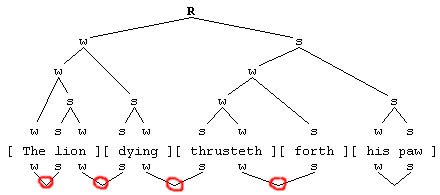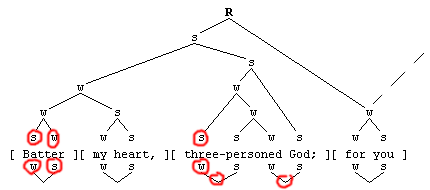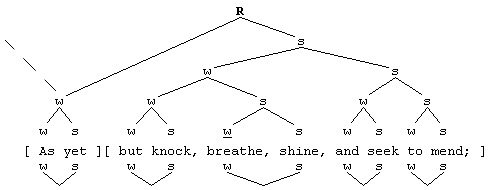4.6 - Some Thoughts on the Relative Merits of Attridge and Generative Metrics
I suggested in section 4.2 that learning both the Attridge and the generative approaches would give a fuller understanding of rhythm. While the beat-offbeat system is probably easier to learn and has a simplicity and clarity in its application, the generative approach nonetheless allows for certain kinds of observations and understanding of poetry that the beat-offbeat system alone may not give. The chief differences result from the emphasis the generative approach gives to syntax and to word-level stress. To demonstrate, let me go back to the line you analyzed in Example 24, here presented using both methods.
(27a)

(27b)

In the Attridge analysis (27 b), this line is a perfectly regular iambic pentameter line with no complexity whatsoever. But say the line outloud to yourself and you will realize that we inevitably focus on the lexical, i.e., word stress in the line. Our first and predominant aural experience is of the words, "lion," "dying," and "thrusteth," all words with a trochaic (s w) or falling rhythm that is at odds with the rising iambic meter. The generative analysis (27 a) reflects this experience in the four bracketing mismatches. Because generative analysis focuses on syntax and insists on the integrity of word boundaries, it is more sensitive not only to the relationship between syntax and rhythm but, through that relationship, to those points in the poem that often are most semantically crucial.
The generative emphasis on syntax also makes us more aware of the relationship between the line as a metrical unit and the syntax, which often does not follow the strictures of line length, as we saw in the enjambment examples and exercises in section 4.4. While Attridge certainly recognizes enjambment, his method does not provide a way to understand how language is grouped in units other than those defined by the line. As you will see in section 5, on rhythmic phrasing, poets work not only with phonological phrases, with which you are already familiar, but also with larger phrasal units. Insofar as the generative approach makes you aware of types of prominence within phrasal groupings, it prepares you to recognize various kinds of phrasal units of the poem, including those at the highest formal levels (e.g., intonation units, stanzas, whole poems) as well as the relationships of subordination and hierarchy that characterize them. Take for instance the Donne line you analyzed in Exercise #11 along with its subsequent line. These together open his Sonnet XIV and they provide a tour de force of Donne's metrical and rhetorical prowess. Here again are both the Attridge and generative analyses.
(28a)


(28b)


Unlike Example 27, where the two types of analysis produced very different results, the two approaches to the Donne lines similarly identify the places of complexity. In the first line, the beat-offbeat method shows an implied offbeat and two sets of double offbeats, the second with a demotion, which places the line well up on the complexity scale. The second line has only a single instance of demotion. By generative lights the first line is unmetrical because of the simultaneous presence of an s in metrical w position ("three") and a bracketing mismatch. The second line has an underlined w, in effect the equivalent of the demotion in the beat-offbeat schema.
So if the approaches have this many similarities, what are the significant differences? The tree structures, by mapping the relative and hierarchical nature of stress, allow us to see graphically that these opening lines are composed of two units balanced against each other, "Batter my heart, three-personed God" and "for you / As yet but knock, breathe, shine, and seek to mend." The strong pause after "God" clearly sets up the enjambment that begins with the new phrase, "for you." Looking at the highest level of tree structure, we see that the main clause is strong while, "for you" is weak. "For you" receives its syntactic completion only in line two. But notice what the line break does. Line two is a series of powerful actions performed by God on the speaker of the poem. But God, the active agent, is confined in the weak position at the end of line one where he is subsidiary both to the commandment given by the speaker to God ("Batter my heart . . . ") and to the strong verbs of line two which the speaker implies are not sufficient to move him, i.e., as yet knocking, breathing and shining are insufficient. While it's true that God is also named directly in the first part of line one, indeed is the syntactically climactic point, it is of course just here that the line becomes unmetrical, suggesting a pre-eminence which is, if not questioned, then rendered less than harmonious. The opening dissonance and rhythmic chaos, packed so forcefully into those first eight syllables, is relaxed after the semi-colon into an extended but nearly regular twelve-syllable unit, despite the remarkable string of monosyllabic verbs.
While nothing about Attridge's method would preclude you from considering syntax and enjambment, there is also nothing to encourage you to do so. The generative approach foregrounds the role of syntax, especially phrasal units; further, by focusing on the relative and hierarchical nature of stress, at both the word and phrase level, we are prepared to see both the larger and smaller structures of the poem in these relational terms. The Donne poem, whose opening lines we have briefly considered, also turns thematically on issues of hierarchy and subordination. You may not wish to see every formal feature as having a thematic parallel; indeed, I would argue that while rhythm can have the function of semantic reinforcement, as it does here, the most powerful function of rhythm is formal and has no strict thematic analogue. How we perceive and understand larger scale phrasal rhythm is the subject of the last section of the tutorial.